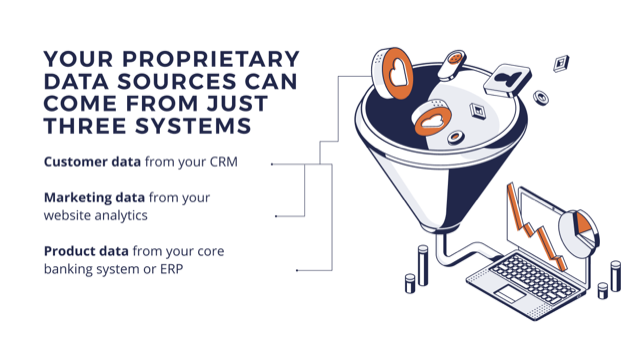Data Driven Marketing for Local Financial Institutions
We are excited to kick off a series of monthly guest posts by friends of Luna Connect. Greg Serandos is a digital marketing strategist from the US and is passionate about helping local businesses compete against large financial institutions. One of those ways is to more effectively use customer data, then launching smarter campaigns to gain competitive advantage.
Introduction
I have been involved in Google advertising since it was invented in the early 2000s, and Facebook advertising since the mid-2010s for banks, insurance companies, and technology startups. So, as digital marketing has become quite mature, I’m surprised that most companies don’t use their proprietary data they have gathered to gain competitive advantage in the market.

Every company has proprietary data. If you only have one customer, you have proprietary data. You know what that customer bought, how much profit you made from them, and if your marketing is set up properly, how they found you. Consider; you spend $1000 on Facebook and $1000 on Instagram, and both return 30 interested customers, that doesn’t help you. But if all 30 Facebook leads turn into approved loans, and none of the Instagram leads convert to loans, you have proprietary data and you can use it to cost-effectively acquire new customers, in this instance, through Facebook advertising.
Digital marketing is indeed complex. The marketing technology (or MarTech) stack is five full layers, each with multiple products, and each product being offered by multiple vendors. The stack includes:
- Marketing and Advertising
- Experiences & Clickstream
- Back Office
- Analysis & Activation
- Governance
For example, the Experiences & Clickstream layer by itself includes web & mobile web, e-commerce, user experiences & Voice of the Customer, A/B and Multi-user testing, personalization, and web analytics. If you are a marketer, you are probably hearing from these vendors almost every day.
Ironically, the bigger the company, the more impossibly complex managing systems and data becomes. Some of your large competitors don’t know how to use their data at all, or they suffer from ’analysis paralysis’ —they go down a rabbit hole trying to create the perfect and most accurate data set and end up feeling overwhelmed and doing nothing with their data. It’s counter intuitive but is good news for small and medium financial institutions..
How you can win
What we marketers should really be trying to do is exploit our proprietary data to make better marketing decisions, and not let perfect get in the way of the good. Should we spend more money marketing to males or females, certain age groups, geographic locations, time of day, week, or month, lead source (Google, Facebook, etc.)? When do we sell certain products to which audiences?
Forget about perfecting the marketing stack. Your proprietary data sources can come from just three systems:
- Customer Data comes from your CRM
- Marketing Data comes from your website analytics
- Product Data comes from your core banking system or ERP
You can readily link these together without hiring radically expensive data scientists and AI experts.
Most of your competitors don’t use their proprietary data to create a marketing advantage. Either they give up before the results are achieved, or they get so inundated with thousands of data points that they throw in the towel. Again, the bigger the company, the harder it is.
You should consider engaging an expert to perform a digital data assessment and make recommendations on how you can use your own data to make better marketing decisions. Once you have a strategy to gain a competitive advantage through your proprietary data, execution becomes the key. Here are the steps.
1. Identify your target audience
There is no greater waste of resources than pushing your advertising campaigns to people who will not benefit from or have any interest in your offering. Data-driven marketing helps brands avoid this by cutting through the clutter to reach the eyes interested in your product or service.
Moreover, once you have succeeded in identifying those online users, you’ll want to build a basis for acquiring them as repeat, loyal customers. The best way of doing this is by having insight into who those individuals are and to target them.
2. Improve Your Customer Experience
Credit unions and local financial institutions have built strong relationships with families and communities, often spanning generations. After all, it’s human experiences that people hold on to - even cling to - especially in the Covid era. Sure, digital technology can handle transactional tasks better, cheaper, and faster than people can manually, but the human touch still matters. That’s why just 15% of US consumers bank exclusively with a consumer fintech.
Successful financial institutions of the future will effectively blend traditional relationships with digital efficiency, speed, and convenience. This is especially true when it comes to borrowing, which has more of an emotional component than, say, savings or investing..
The truth is, most major banks have outsourced so many processes and driven so much cost out of their systems that, unless you are a high value client, their service levels have fallen dramatically. This is the opportunity for local financial institutions like credit unions - to augment strong relationships with really great digital experiences. The secret is to always be customer centric at every step of the customer journey..
3. Use Tailored Messaging to Build Highly Targeted Campaigns
Data-driven marketing can aid in creating the right kind of campaigns to capture your target consumers' attention. With highly targeted, unique campaigns consisting of personalized messaging for each customer, businesses can build solid business-to-customer relationships and a loyal customer base.
Organizing your data will help you create all your content with greater intent for better engagement. With information about your customers' interests, lifestyle, and online activity, you can craft content that they would like to see. Your messaging should be unique and consistent across your chosen channels to capture your audience’s attention and to position your brand as a reputable source. Tailored messaging will make you memorable over your competitors fighting for similar customer recognition.
4. Segment Your Audience
In the digital age, offering a personalized customer experience is achievable by segmenting your audience. Segmenting your audience tends to every interested pair of eyes at various stages in the sales funnel. As an example, perhaps several potential customers have not completed their applications; a friendly prompt to consider completing the purchase is appropriate targeted messaging at this phase.
Because your customers are at different stages of the buyer's journey, you must craft separate messaging to help urge them forward. Personalization is another integral part of successful data-driven marketing as it aids the automatic updating of customer data, otherwise called bi-directional integration. Personalization also provides direction regarding which platforms are most suitable to yield the best possible results for your offerings.
Conclusion
To begin embarking on the data-driven organization journey, you must establish a specific set of goals that will be the driving force behind all your marketing decisions. Usually, a common goal is to grow your customer base, attract new customers, and increase your loan book. Your proprietary data can help you do that by indicating weak areas and those of strength that you could push even further. In turn, this can help you allocate your marketing budget more effectively and eventually help you streamline your processes.
During this digital age, businesses will find the most benefit in using proprietary data to make intentional marketing decisions. The benefits of doing this include improved personalization, a better customer experience, more creativity, and increased ROI.
There are four things you can consider taking on to achieve this:
- Proprietary data assessment to unpack your data sources to identify ways to gain marketing advantage.
- Digital assessment to identify gaps and provide the basis for a technology roadmap.
- Customer journey mapping to ensure you continue providing great customer experiences as you digitize your business.
- Digital experience platform that integrates with your core banking systems so you can provide digital experiences in days and weeks.
Greg Serandos is CEO of Sausalito Digital Advisors. He advises FinTechs and financial institutions on strategy and marketing. He can be reached at greg@sausalitotech.co

